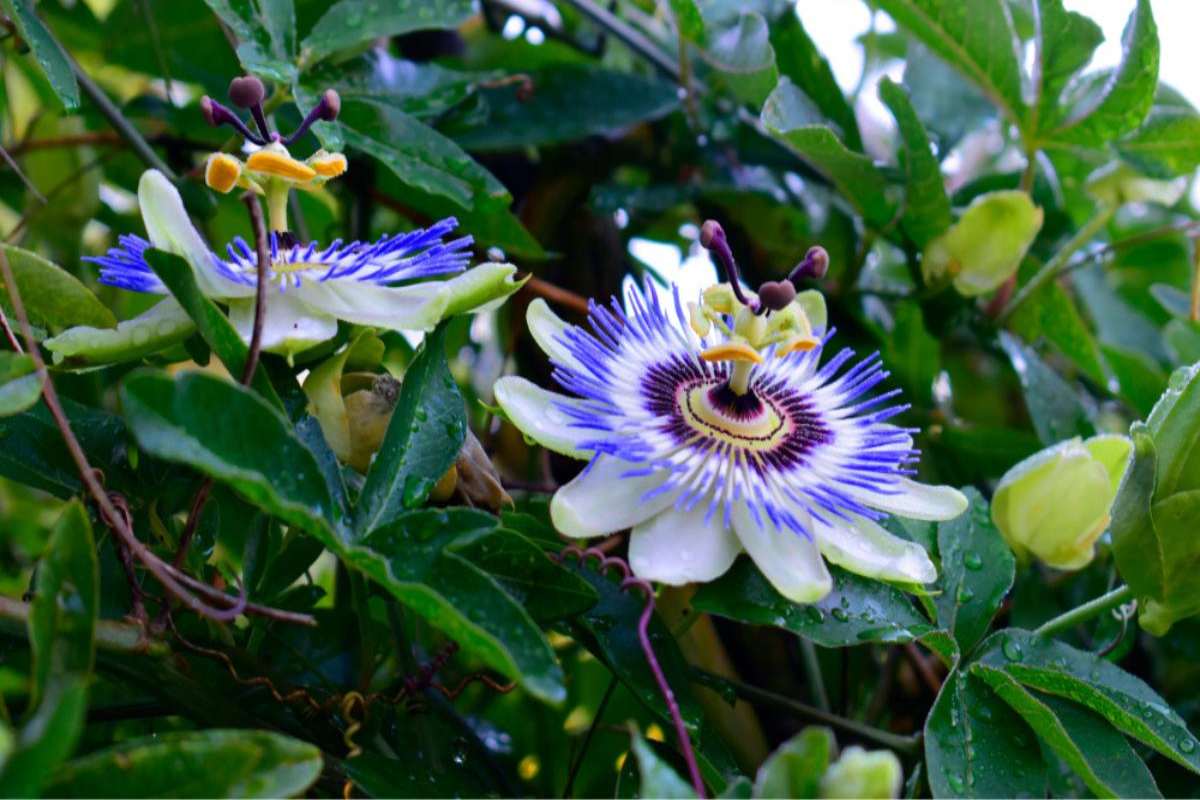Passiflora Caerulea flower is also known as blue passion flower or blue crown passion flower. The flowering plant is primarily grown for its exotic-looking flowers. It is a climber belonging to the Passifloraceae family. The plant is native to South America. A perennial vine usually up to 10 meters tall. However, it can grow up to 25 meters in height depending on the weather conditions and the care it is given. The flowers on the vine bloom mainly in summer.
The Passiflora caerulea flower is often referred to as the “clock plant” in Japan because of its shape. The fruit of the plant is orange-yellow in color and oval in shape. The fruit can eaten when ripe, but it contains more seeds than pulp. Blue passion fruit has a milder flavor than other passion fruit. However, it is used as a flavoring for tea, beverages, ice cream and jam. This flowers are also known for their medicinal properties. Passiflora caerulea tea is recognized for its healing effect.
Table of Contents
About Passiflora Caerulea
One of the most attractive indoor climbing and flowering plants is the award-winning Passiflora caerulea, a large, vigorous, semi-evergreen climber with twining tendrils. The mysterious beauty of its flowers is absolutely charming, being pink with white thread rings, sometimes blue, white and purple. The blue crown passion flower is the most common of all passion flowers.
Passiflora Caerulea has bright, dark green leaves and best of all, it has special religious significance. Beauty + Symbolism is the perfect combination found in nature. Passionflower actually makes some of the most beautiful flowering plants.
Origin of Passiflora Caerulea
Passiflora Caerulea is a perennial vine inborn to South American nations and areas such as southern Brazil, Argentina, Paraguay and Uruguay. It has been consciously introduced as an attractive flowering plant to various parts of the world and has now established itself as an invasive species in New Zealand, Hawaii, the coastal islands of Chile and possibly other Pacific islands. established as
Passion Fruit
The showy 8cm multicolored flowers also produce edible fruit from late summer through autumn. Passion fruit has a fresh taste. A sweet but acidic taste and aromatic aroma. It is difficult to compare them with other fruits because they are unique. In tropical regions, they are mixed with sweet fruits to provide some counterbalance. If you’re wondering what they taste like: think a little like a kiwi, a little like a pineapple.
The plant is evergreen, especially in tropical weathers, but is deciduous where winters are cold. Did you know that this amazing plant was known to survive in temperatures as low as 5 degrees Fahrenheit when the ground was frozen more than two feet deep? Best of all, Passiflora Caerulea is an indoor and outdoor plant. Read the article ‘Study reveals the best houseplants in 147 countries around the world’ to find out where Passiflora Caerulea is most popular around the world.
Medical Uses of Passiflora Caerulea
Medical uses of “blue passion flower” include anti-inflammatory and anti-diarrheal properties. The fruit is good for digestion when eaten raw, and a tea made from its leaves or roots is effective against gastrointestinal signs and infections. As well, the roots and leaves, when made into a tea, inhibit and flush out intestinal parasites. The fruit is traditionally used in Brazil and Mauritius as a sedative for insomnia.
How to Grow This Bluecrown Passionflowers
Despite its tropical appearance, Passiflora Caerulea or “Blue-crowned Passionflower” can actually be grown anywhere, even in colder climates. In fact, some types of passionflower can spread quickly in hot climates, so you may even find these seemingly fragile vines blooming along the roadside.
Passiflora Caerulea is usually grown on a trellis, fence or other vertical structure where they are hardy. These plants are often planted in pots and carried indoors for the winter in climates where they are not hardy. They must generally be planted in average, but well-drain soil, in full sun or light shade. For many species, which can be damaged by strong winds or bad weather, a shelter is recommended, such as against a garden wall.
The Light
You can Plant your Passiflora Caerulea plant in full sun or partial shade to keep it blooming and healthy. In very hot areas, plants benefit from some afternoon shade. Blue passionflowers generally need four to six hours of sunlight per day (or more in cold weather). Give potted plants bright, indirect light and possess them out of drafts if you move them indoors in winter.
Water
After planting, the passion flower must be well watered. Also, during their growing season, they usually bloom with a weekly or bi-weekly watering. Give 1 to 1.5 inches of water weekly.
Planting and soil
Passiflora Caerulea must be planted in fertile, moist soil that drains well. Soil pH is not critical and range from 6.1 to 7.5, which is in the impartial to acidic range. Spread on mulch around the base of the plant will help retain moisture without overwatering it, and addition compost to the planting hole will help provide nutrients.
Conclusion
Passiflora Caerulea flower is undoubtedly one of the most beautiful flowers. Nurturing is easy. With some care, the Passiflora Caerulea vine spreads quickly and produces beautiful flowers that add to the beauty of your garden. Its sweet fragrance fills the place with a charming atmosphere. We must not forget that it has medicinal properties. Passiflora Caerulea tea is known to calm the mind and reduce anxiety. Because of this, it is popular in many parts of the world. However, the flower should not be used for healing purposes without expert advice.

